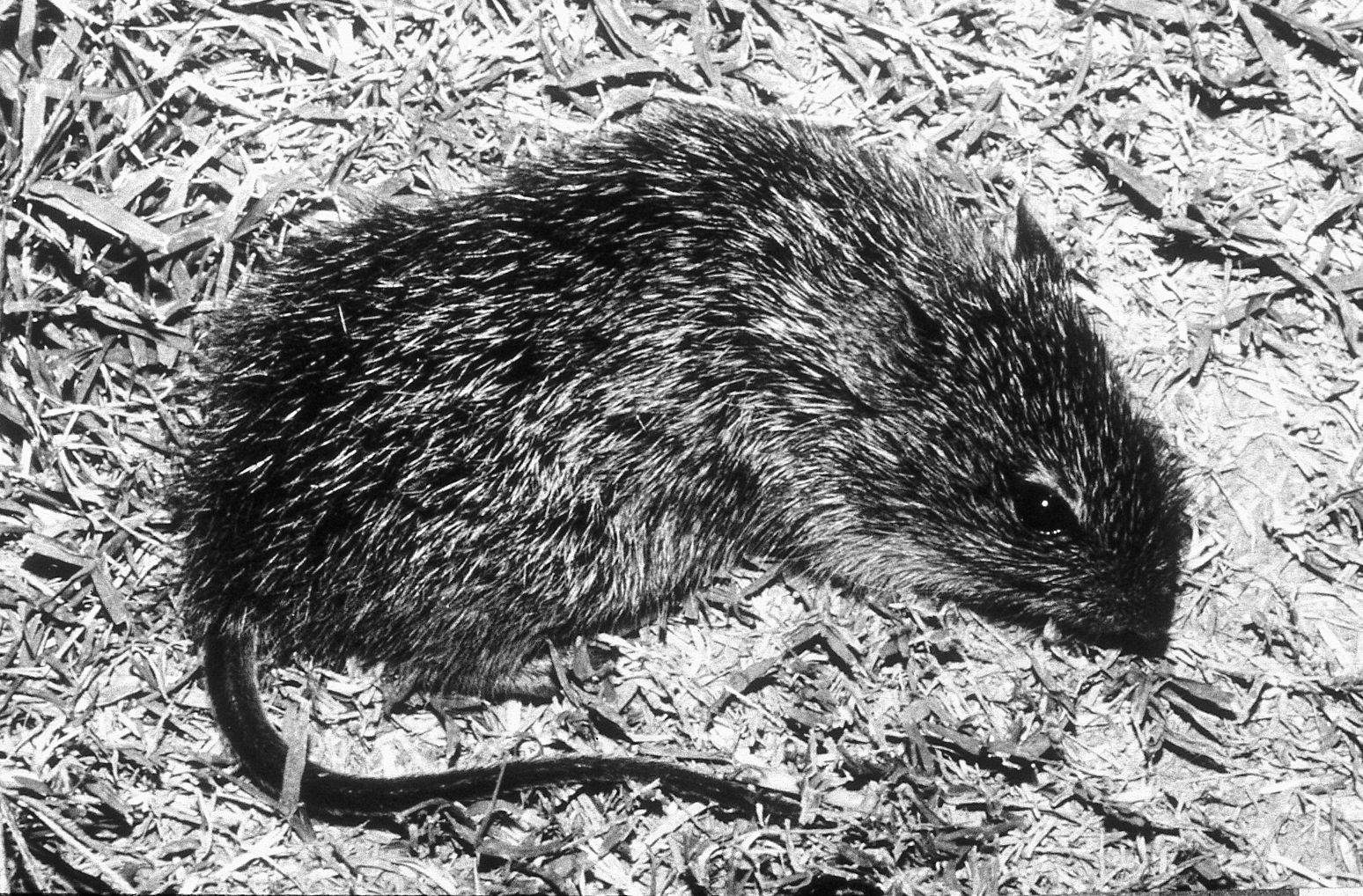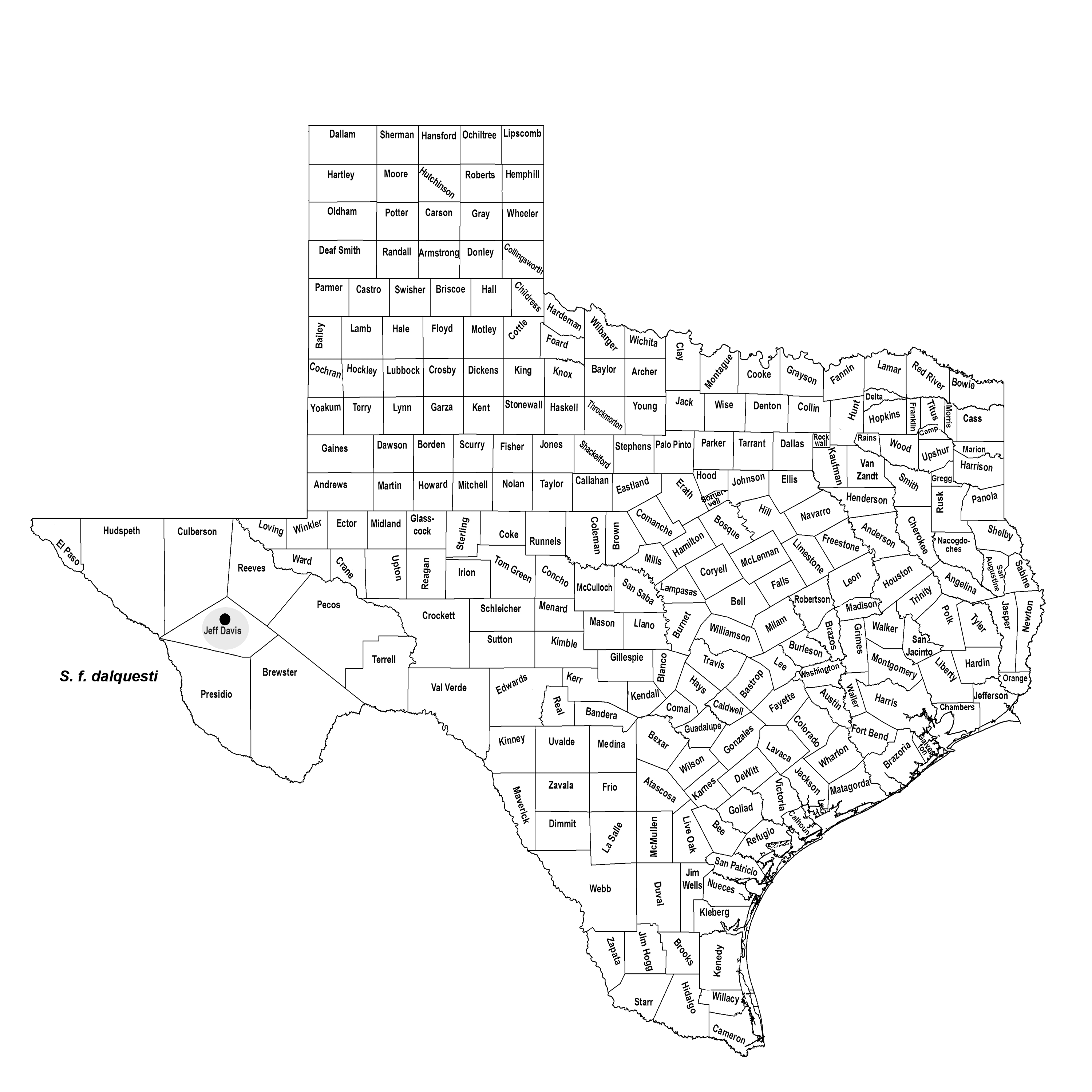TAWNY-BELLIED COTTON RAT
Sigmodon fulviventer J. A. Allen 1889
Order Rodentia : Family Cricetidae
DESCRIPTION. A small to medium-sized cotton rat with brownish, buff brown, or fulvous underparts from throat to anus. Dorsal coloration is light brown, heavily speckled with dark brown to black, giving a salt-and-pepper or hispid appearance. The tail is uniformly blackish, and the tops of the feet are buff brown. Dental formula: I 1/1, C 0/0, Pm 0/0, M 3/3 × 2 = 16. External measurements reported for the holotype of S. f. dalquesti from Fort Davis were, total length, 242 mm; length of tail, 90 mm; hind foot, 28 mm; ear, 18 mm.
The tawny-bellied cotton rat is similar in appearance to two other cotton rats that occur in Texas. From the yellow-nosed cotton rat (S. ochrognathus), S. fulviventer differs in having a rich buffy ventral coloration rather than whitish, a more heavily speckled dorsal coloration, buff-colored tops to the feet rather than grayish, and a uniformly dark-colored tail. Also, S. fulviventer lacks the tawny-colored nose of S. ochrognathus. The hispid cotton rat (S. hispidus) differs from S. fulviventer in having gray or whitish underparts, a bicolored tail that is lighter below than above, grayish tops of the feet, and slightly larger ears and hind feet.

DISTRIBUTION. In the United States, known from grassland habitats in southeastern Arizona and southwestern New Mexico to the middle Rio Grande Valley; in Texas, known only from an isolated population near Fort Davis in Jeff Davis County.

SUBSPECIES. Sigmodon f. dalquesti.
HABITS. The tawny-bellied cotton rat inhabits grassy areas interspersed with shrubby growth that affords cover and allows dense growth of grasses. In Mexico, these rats are associated with bunchgrasses in the mesquite–grassland vegetation type. Over their limited range in Arizona and New Mexico, tawny-bellied cotton rats are found in weedy and grassy places in pinyon–juniper–live oak woodland, Mexican oak–pine woodland, and mesquite–yucca–grassland vegetation types, where their runways are hidden in the thick, grassy cover.
Previously unknown in Texas, the tawny-bellied cotton rat was first recorded in spring 1991 near Fort Davis by Fred Stangl of Midwestern State University. This isolated population represents not only a new species of mammal for Texas but also appears to be a new subspecies, S. f. dalquesti. Within a general area described as a "heavily grazed, level valley plain" with "small, scattered mesquite, catclaw, and a fence line" that protected against livestock grazing, tawny-bellied cotton rats were caught in dense grasses along fencerows and in adjacent grassy areas protected by clumps of mesquite and catclaw acacia. Hispid cotton rats were also caught in these areas.
Of 20 Texas specimens captured in late March, 8 were juveniles. Both adult males were in reproductive condition, and of the 10 mature females, 1 was lactating and 4 were pregnant. Embryo counts revealed one litter of three and three litters of four.
POPULATION STATUS. Enigmatic. The extent of the tawny-bellied cotton rat's range and relative abundance remain unknown. Given that it is known from only a single location in the Davis Mountains and subsequent attempts to document it at the same place (and surrounding areas) have failed suggests that it is extremely rare or perhaps extirpated.
CONSERVATION STATUS. The IUCN lists the tawny-bellied cotton rat as a species of least concern, and it does not appear on the federal or state lists of concerned species. It probably should be listed as one of the state's rarest and most threatened rodents. Some sort of protective status seems clearly warranted.
From The Mammals of Texas, Seventh Edition by David J. Schmidly and Robert D. Bradley, copyright © 1994, 2004, 2016. Courtesy of the University of Texas Press.
Natural Science Research Laboratory
-
Address
Museum of Texas Tech University, 3301 4th street, Lubbock, TX 79409 -
Phone
806.742.2486 -
Email
nsrl.museum@ttu.edu

